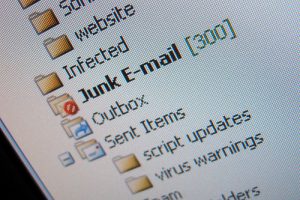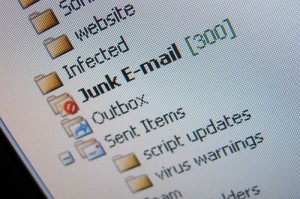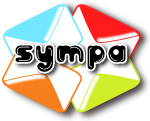[:en]
Just before the weekend, we became aware of a particularly intrusive and persistent phishing attack. An e-mail, seemingly from Standard Bank, was distributed from a staff member’s e-mail account after being hacked.
In order to prevent the attack from causing more damage to other e-mail users, stricter spam filter measures had to be implemented over the weekend. After this time period, the filter was reset to its default.
These measures caused some e-mails that weren’t spam, to divert to Outlook’s Junk Mail folder. They were not deleted, but they weren’t visible in inboxes.
Even though it is advisable that you occasionally check your Junk mail folder, it seems some staff aren’t familiar with the folder or it’s function.
The Microsoft Outlook Junk E-mail Filter helps reduce unwanted email messages in your Inbox. Junk e-mail, also known as spam, is moved by the filter away to the Junk E-mail folder.
 How the Junk E-mail filter works
How the Junk E-mail filter works
The Junk E-mail Filter evaluates each incoming message to assess whether it might be spam, based on several factors. These can include the time when the message was sent and the content of the message. By default, the Junk E-mail Filter is turned on and the protection level is set to Low. This level catches only the most obvious spam. You can make the filter more aggressive by changing the level of protection that it provides.
You can adjust the Junk E-mail Filter settings in the Junk E-mail Options dialogue box.
-
On the Home tab, in the Delete group, click Junk, and then click Junk E-mail Options.
Any message that is suspected to be junk is moved to the Junk E-mail folder. We recommend that you periodically review the messages in the Junk E-mail folder to check for legitimate messages that were incorrectly classified as junk. If you find a message that isn’t junk, drag them back to the Inbox or to any folder. You can also mark the item as not junk by doing the following:
-
On the Home tab, in the Delete group, click Junk, and then click Not Junk.
More detailed instructions can be found on the Office365 Knowledgebase and on Microsoft’s website.
We apologise for the inconvenience and confusion caused by these emergency measures. If you have any questions, please contact the IT Service Desk at 021 808 4367 or help@sun.ac.za.
[:af]
Net voor die naweek het ons bewus geraak van `n ernstige en aanhoudende phishing-aanval. `n E-pos wat homself voordoen as kommunikasie vanaf Standard Bank is op kampus versprei omdat een van ons personeellede se e-pos deur `n kuberkraker blootgestel is.
Om te voorkom dat verdere skade aangerig word aan ander e-posgebruikers, moes strenger gemorspos filters in plek gesit word vir `n kort tydperk die naweek. Dis egter weer na die tydperiode gelig en na normaal verstel.
Hierdie noodmaatreëls het veroorsaak dat sommige veilige e-posse ook geklassifiseer is as gemorspos en is gevolglik na die Junk e-mail folder versend. E-posse is nie uitgevee nie, maar was steeds beskikbaar in die leêr.
Ons beveel aan dat jy gereeld jou Junk e-mail lfolder nagaan om seker te maak dat jy nie belangrike e-posse mis nie. Indien jy nie bekend is met hierdie funksie nie – Die Microsoft Outlook Junk E-mail filter se doel is om ongewensde e-pos boodskappe weg te hou uit jou posbus. Gemorspos of spam word gefilter vanaf jou hoof-posbus na jou Junk E-mail folder.
Om jou Junk E-mail folder se filter self te verstel, volg asb. die instruksies soos onder verskaf.
 How the Junk E-mail filter works
How the Junk E-mail filter works
The Junk E-mail Filter evaluates each incoming message to assess whether it might be spam, based on several factors. These can include the time when the message was sent and the content of the message. By default, the Junk E-mail Filter is turned on and the protection level is set to Low. This level catches only the most obvious spam. You can make the filter more aggressive by changing the level of protection that it provides.
You can adjust the Junk E-mail Filter settings in the Junk E-mail Options dialog box.
-
On the Home tab, in the Delete group, click Junk, and then click Junk E-mail Options.
Any message that is suspected to be junk is moved to the Junk E-mail folder. We recommend that you periodically review the messages in the Junk E-mail folder to check for legitimate messages that were incorrectly classified as junk. If you find a message that isn’t junk, drag them back to the Inbox or to any folder. You can also mark the item as not junk by doing the following:
-
On the Home tab, in the Delete group, click Junk, and then click Not Junk.
More detailed instructions can be found on the Office365 Knowledgebase and on Microsoft’s website.
We apologise for the inconvenience and confusion caused by these emergency measures. If you have any questions, please contact the IT Service Desk at 021 808 4367 or help@sun.ac.za.
[:]





 The opposite of spam is, believe it or not, ham. In other words e-mails you WANT to receive.
The opposite of spam is, believe it or not, ham. In other words e-mails you WANT to receive. If you’ve used Outlook to send emails to large group of people up till now, you would’ve noticed it limits you to 120 addresses. Sympa allows you to send to an unlimited amount of addresses. You can also create multiple lists and choose descriptive names for your lists. Just remember, the list’s name is also the email address you’ll be sending your mails from, so choose wisely.
If you’ve used Outlook to send emails to large group of people up till now, you would’ve noticed it limits you to 120 addresses. Sympa allows you to send to an unlimited amount of addresses. You can also create multiple lists and choose descriptive names for your lists. Just remember, the list’s name is also the email address you’ll be sending your mails from, so choose wisely.